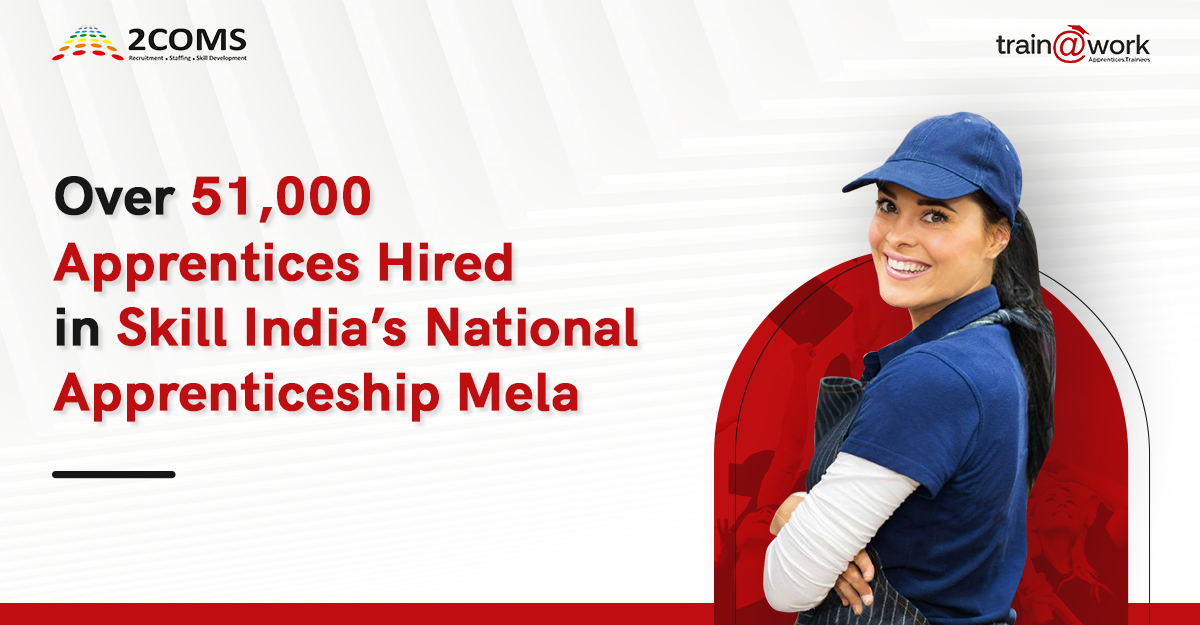NAPS by Skill India aims to provide hands-on experience to candidates through apprenticeship. Know more about NAPS and how 2COMs can help, right here.
On July 11th, 2022, the Ministry of Skill Development and Entrepreneurship (MSDE) conducted the Pradhan Mantri National Apprenticeship Mela as a part of the Prime Minister's Skill India Mission to increase work opportunities and practical training. With the proper assistance from the Directorate General of Training (DGT) and the National Skill Development Corporation (NSDC), 67,035 people were employed as apprentices. Let's examine what makes Skill India's Apprenticeship Mela unique.
Over 5000 organisations from over 30 industries participated in the event, including Power, Retail, Telecom, IT/ITeS, Electronics, Automotive, and more. The nation's aspiring youth also had the chance to interact with and choose from over 500 trades (Designated and Optional). Some of the top positions at the Apprenticeship Mela this year were for mechanics, housekeepers, beauticians, welders, and more.
What sets the Apprenticeship Mela apart?
∙ Aim of the Apprenticeship Mela
The Honourable Prime Minister announced the National Policy of Skill Development and Entrepreneurship on July 15th 2015. It recognises apprenticeship to give talented workers meaningful employment with fair wages. The MSDE has also attempted to encourage businesses around the nation to employ more apprentices.
By obtaining on-the-job training and achieving improved career chances, the goal is to close the skills shortage and satisfy the ambitions of the Indian youth. By doing so, they aim to raise the nation's skill standards and realise the goal of a 'Skilled India'.
∙ Eligibility criteria for apprentices
This program's primary goal is to persuade businesses to take on more apprentices while supporting employers in identifying and nurturing apprentices' potential through training and hands-on experience.
To be eligible, participants must hold a diploma from grades 5-12, a certificate of skill training, an ITI diploma, or a graduate degree. Candidates will graduate with credentials recognised by the National Council for Vocational Education and Training, increasing their employability.
∙ Eligibility criteria for employers and basic training providers
For employers
- The employer must have a TIN/TAN number.
- Employers must sign up on the apprenticeship platform.
- The employer must also have an EPFO, ESIC, Factory, Collective, or MSME registration number.
- Employers must have a bank account connected to Aadhar.
- Employers must hire apprentices between 2.5% to 10% of their workforce per the law.
For basic training providers
- Aadhar-linked bank account is required for BTPS.
- BTPS have to sign up on the apprenticeship platform.
- RDAT must physically verify basic training providers
Apprenticeship training is the most long-lasting approach to skill development for offering demand-driven skills and filling businesses' technical skill shortages. By promoting such efforts, Skill India can help businesses and candidates benefit fully from apprenticeship training by encouraging advancements in earn-while-learn-based learning systems.
The event provided a fantastic opportunity for the taking part establishments, who could choose the applicants based on their needs after having the possibility to meet potential apprentices on a shared platform. Important organisations like the Railways, ONGC, Tata, Maruti Udyog, and many more took part in the event.How does India benefit from Apprenticeship training?
The apprentices earn wages from the very first day of their apprenticeship. Once they complete the program, they receive industry-issued credentials and certificates. They also have the option to grow their career in their desired field.
New reforms that give a boost apprenticeship in India
- The maximum percentage to hire apprentices has been raised from 10% to 15%.
- Payment of the apprentice's stipend for the first year has been fixed rather than tied to minimum wages, and it will increase by 10% to 15% in the second and third years.
- The business sector has the flexibility to create and operate its apprenticeship program.
- The govt. has reduced the maximum size of a business that must hire apprentices from 40 to 30.
- Apprenticeship training for Optional Trade might last anywhere from six months to three years.
- Under the National Apprenticeship Promotion Scheme (NAPS), businesses and industries are eligible for up to a 25% reimbursement of the apprentices' stipends.
- Small-scale businesses must have a minimum of four employees to employ apprentices.
Features of the National Apprenticeship Promotion Scheme (NAPS)
The Government of India introduced NAPS to encourage apprenticeship nationwide by offering financial incentives, technology, and advocacy assistance. The plan consists of the following two elements:
- Sharing with the employers 25% of the authorised stipend, up to a maximum of INR 1500 per apprentice per month.
- A maximum of INR 7,500 per apprentice will be shared for the expense of the basic training.
Some features of NAPS include:
-
More options for the apprentices and integration with other programs
Coursework for programs like PMKVY, DDU-GKY, and others must be integrated with apprenticeship training. These programs will be granted the status of optional trades, and the program's authorising authority will include any necessary practical material for on-the-job training.
-
Ease of Technology Administration
The complete online execution of the Apprenticeship Training shall be administered using the specifically created website 'https://www.apprenticeshipindia.gov.in/' It will make meeting the needs of all important parties easier, including candidates, industry, DGTs, RDSDEs, NSDCs, SAAs, SSDMs, and BTPs.
-
Promoter and Facilitators/Third Party Aggregators (TPA)
As this scheme involves several parties, facilitators or TPAs are crucial for mobilising apprentices, matching their preferences with the needs of the establishments for the apprenticeship opportunities posted on the portal, and assisting the establishment in locating Basic Training Providers. TPAs are hired following the criteria established by MSDE for their selection.
-
Involvement of States/UTs
Following the Apprentices Act, the various State Governments oversee apprenticeship training in State Public Sector Undertakings and Private Sector Establishments.
States play a significant role in programme implementation since they have authority over most MSMEs and smaller industries. Therefore, it is crucial and a top priority to educate the states, State Skill Development Missions (SSDMs), and officials up to the District level on the goals of the reforms.
The Central and State governments' District Skilling Committees will be tasked with locating apprenticeship opportunities in their districts and expected to ensure their proper utilization.
Looking forward to avail NAPS benefits ? 2COMS can be your apprentice hiring partner! We empower firms with apprentice hiring & implementing apprenticeship program in the right way.





























